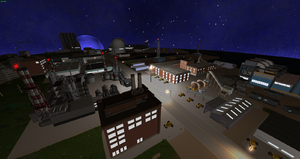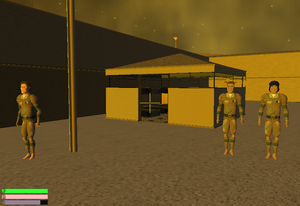City: Difference between revisions
m (Added Template:Revision tag.) |
(Added Template:NewVersion.) |
||
| Line 1: | Line 1: | ||
{{NewVersion | |||
| Update = [[Building Update]] | |||
}} | |||
{{Revision|This page has a lot of information that could be moved to separate pages. This page is lacking a lot of links.}} | {{Revision|This page has a lot of information that could be moved to separate pages. This page is lacking a lot of links.}} | ||
[[file:CityDowntown.png|thumb|right|A neatly built downtown area of a city.]] | [[file:CityDowntown.png|thumb|right|A neatly built downtown area of a city.]] | ||
Revision as of 14:59, 3 July 2018
| This page contain information about a feature that has two versions.
To read about the old version, go to City/OldVersion. For more information, go to the Building Update page. |
| This section is in need of revision. Please help improve it or discuss these issues on the talk page. The reason given is: This page has a lot of information that could be moved to separate pages. This page is lacking a lot of links. |

Cities are the centers of civilization on developing worlds. Cities are constructed using buildings and roads. Buildings house the industries that manufacture commodities and equipment.
Cities create status reports for the people in their chain of command four times per game-universe day. There are twenty-eight game-universe days per real day so a status report is sent about every thirteen minutes. Status reports show changes in jobs, population and morale. Note that population and morale changes occur at the time the report is generated. The result of the report is the status quo in the city until the next status report is generated. Morale does not fluctuate between status reports. Population may change between reports due to spacecraft passenger traffic or the casualties of war. Jobs fluctuate between reports when new jobs are created, when current jobs are finished, or when jobs get halted or resumed. City status reports provide the information needed to manage the morale and population of a city's inhabitants.
City status reports are accessed on the Governance (F12) window. Go to the Places tab and right-click a city name to request the most recent report or a history of reports. When the most recent report is requested, you actually receive the last two so you can compare them easily.
Zone of Control
Cities represent the presense of a growing civilization that has advanced beyond nomadic hunters and gatherers. A city is symbolic of a larger populace present in its region of the world.
Worlds are divided into resource zones. A city controls the resource zone that contains the town square of the city. Control of a resource zone enables your empire to block construction in that zone by other empires. The Zone Build Permission policy of an empire determines what other empires are permitted to build in the zones controlled by your cities.
Cities often overlap more than one resource zone. Cities do not control the zones they overlap, only the zone that contains the town square.
When cities of different empires exist within the same zone, their zone build permission policies affect each other. For example, empire A and empire B are friends. Empire A permits friends to build in their zones; empire B does not. Empire B is free to expand their city and build more cities. Empire A cannot build any new construction of any kind.
City Capturing
Each city is controlled by an empire. The empire who controls the flag at the town square controls the city.
For more information, see the City Conquest page.
Morale
The morale of a city's population determines if population is immigrating or emigrating. When morale is zero or positive, population will try to immigrate into the city. When morale is negative, the population will emigrate out of the city.
For more information, see the City_Morale page.
Loyalty and Occupation
Citizens of a city are loyal to their empire. Loyalty is reported as a percentage on the city status report. This is the percentage of the citizens who are loyal towards the empire who controls their city.
When citizens move into a city, they are not immediately loyal to the controlling empire. Their loyalty is gained slowly, at about one person per city report cycle. It is typical for the loyalty percentage to change a lot when the population of a small city grows quickly.
When a city is conquered, citizens remain loyal to their previous empire. This is reported as disloyalty to the occupier in their city status reports. The disloyalty of citizens drops slowly, at about one person per city report cycle. When the disloyalty level reaches zero, the citizens change their allegiance to the empire who controls the city; then loyalty toward their new empire begins to rise.
A city that is disloyal toward the controlling empire is an occupied city.
Occupied cities may send city occupation reports to their previous empire at the same time that they send city status reports to the controlling empire. The likelihood of a city occupation report at each city report cycle decreases as loyalty toward the previous empire decreases.
While a city is occupied, the controlling empire cannot construct or demolish any buildings or roads. Construction must wait until the citizens change their allegiance.
Disloyalty towards an occupier affects the productivity of the citizens. Citizens become more productive as disloyalty decreases. While disloyalty is high, construction and manufacture by citizens is slowed.
Occupation affects the morale of citizens. Citizens incur a morale penalty that decreases as disloyalty decreases.
Occupation prevents drafting of local citizens. While a city is occupied, troops cannot be drafted from the populace by defense bases. The only way to increase the number of troops at a defense base in an occupied city is to bring them to the base from elsewhere.
Loyalty and Neglect
Loyalty of city population tends to increase in favor of the owner of the city, at the rate of one citizen per report cycle.
Neglect begins 14 days after a city was last visited by its empire. A city is considered to be visited whenever an officer or avatar, of its empire, is present in the city's solar system for at least one minute. A city is also considered visited when it receives tribute from another city.
Once the population feels neglected, loyalty decreases by one at each city report cycle, instead of increasing by one, until it reaches zero.
When the loyalty of the population is at zero and their morale is below zero, they will revolt.
For more information, see the City_Neglect page.
Inventory and Power Reserve
Each city maintains an inventory of all commodities stored within its buildings. The size of the inventory depends upon the buildings present in the city. The construction page contains a table showing the amount of storage added by different buildings. The inventory size limit is applied to each commodity individually. A city with an inventory size of 100 can store up to 100 units of each commodity: 100 vegetables, 100 beans, and 100 mechanical parts for example.
A city's inventory may contain a mixture of qualities of the same commodity. The combined total may not exceed the inventory size. A city with an inventory size of 100 might have 30 beans of quality 200 and 45 beans of quality 125, leaving room for 25 more beans, but the total amount of beans in stock will not exceed 100.
Construction and manufacturing processes fetch materials from the city's inventory as needed. The resulting quality of construction and manufacturing is the average quality of the components used to make the building or product. To produce the best products and buildings, a city supplies the best quality commodities from its inventory before the poorer quality commodities.
A city will buy and sell commodities from its inventory to spacecraft. A spacecraft may trade cargo with any city if the ship is physically present on a road slab of the city. When a city has an airport, spacecraft may trade cargo with the city if they are near a friendly space station in the solar system. A space station acts as a trade hub for all friendly cities in the solar system.
Cities strive to improve the quality of their inventories. When a city manufactures, imports, or buys commodities, the city replaces lower quality commodities if necessary to fit the new commodities into its inventory. A city will not buy, import, or manufacture commodities of lower quality if they will not fit into its inventory. This improves the quality of its inventory whenever possible, which improves the quality of the commodities it manufactures and the buildings it constructs.
Power reserve is treated much like the city's inventory. Electricity is stored in the power reserve when it is produced, not in the city's inventory. Electricity always has quality 255; there is no poor quality electricity. The size of the power reserve is based on the presence of certain buildings; the power reserve added by each building is shown on the table on the construction page. Buildings and roads use varying amounts of electricity from the power reserve depending upon the size of buildings, manufacturing processes, life support, and electric lighting. Spacecraft may purchase electricity from the power reserve to recharge their capacitors and cities will purchase electricity from spacecraft.
Ringworlds provide power as part of the ring hull infrastructure. Ringworld power is adequate to supply manufacturing processes and lighting. Defense bases require a great deal of power to be readily available in city capacitors. For this reason, power plants should be built in ringworld cities that have defense bases.
Abandonment Decay
Cities decay to remove unused and unwanted data from the game. Limited server resources require that unused things be removed, for the benefit of those things that matter to active players.
For information, read the City_Abandonment and Decay pages.
Citizen DNA

The DNA of a city's its population may differ from the DNA of the indigenous population.
Citizens emerge from a city to greet visiting avatars and when they are loaded as officers, crew, troops and passengers. When citizens emerge, their DNA is determined as follows.
- In a harsh environment, all citizens will have the citizen DNA of the city.
- In a habitable environment, where the citizens are sexually compatible with the indigenous population, 15% of citizens will have the citizen DNA of the city, 25% of citizens will have the indigenous DNA, and the remaining 60% will be a combination of the citizen and indigenous DNA.
- In a habitable environment, where the citizens are sexually incompatible with the indigenous population, all citizens will have the citizen DNA of the city. The city will then also get a -1 alien invader morale penalty.
The citizen DNA of a city is set to that of the avatar founding the city, it can however changed the following ways.
- Citizen DNA of a city is changed when a citizen is added to a city that has a population of 0. Citizens unloaded, garrisoned, deserted, or lost in a city are added to the city's population.
- Citizen DNA of a city is changed to the indigenous population DNA when the population of the city is reduced to zero. Only habitable worlds in the habitable orbit zone have an indigenous population.
- Citizen DNA of a city is changed when a genesis device detonates in the resource zone of the city, if the city's population is zero after the device detonates.